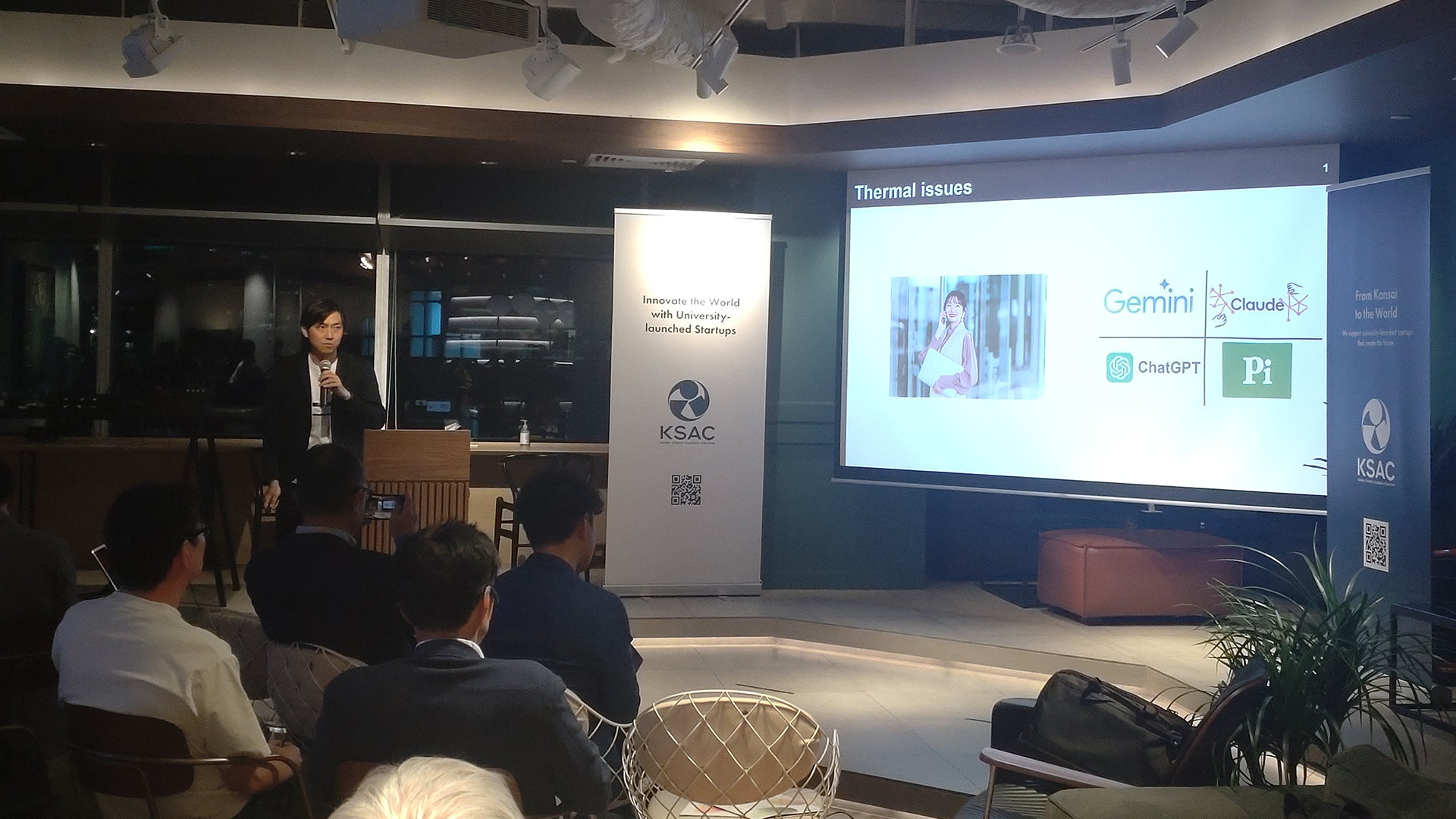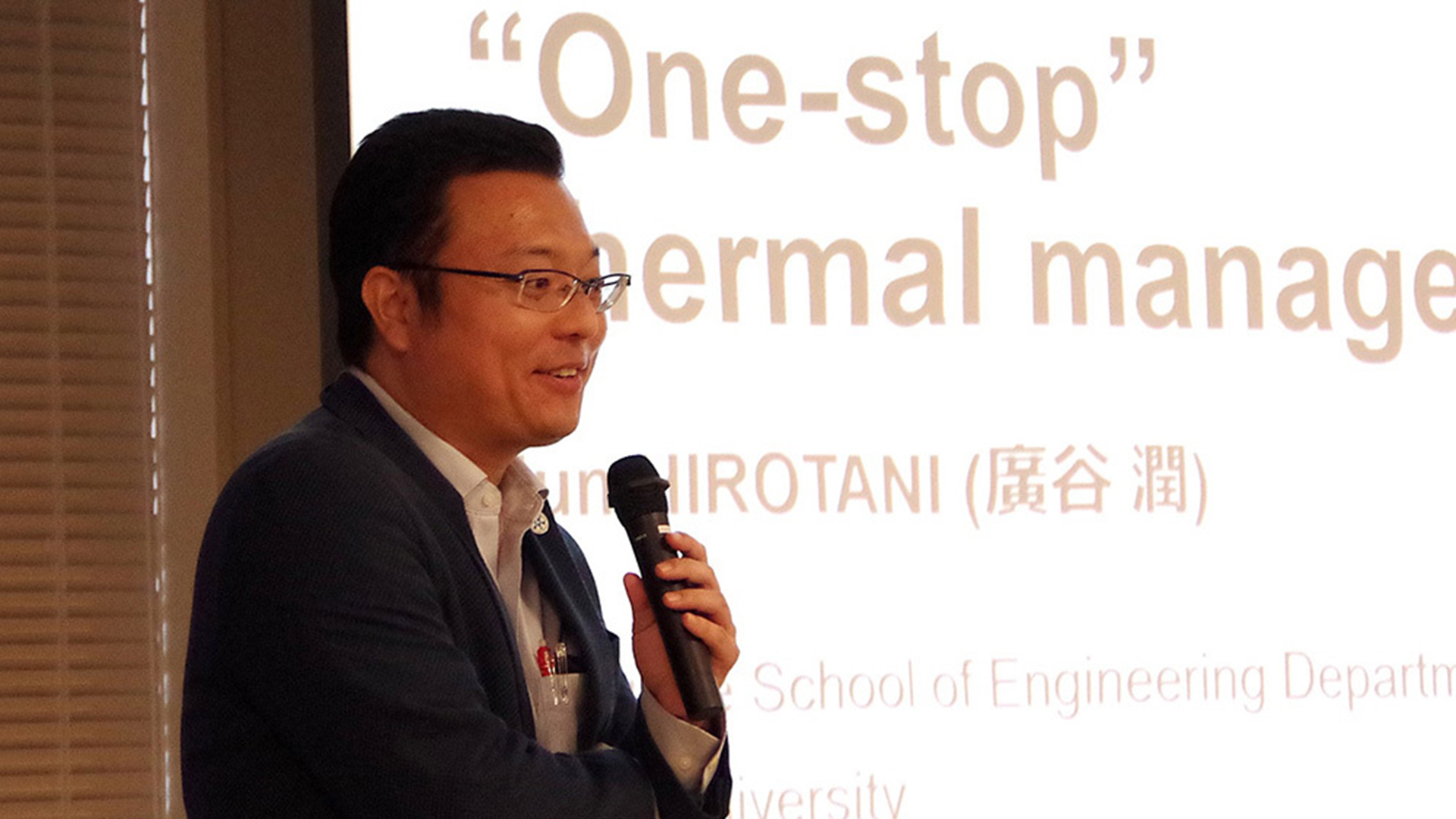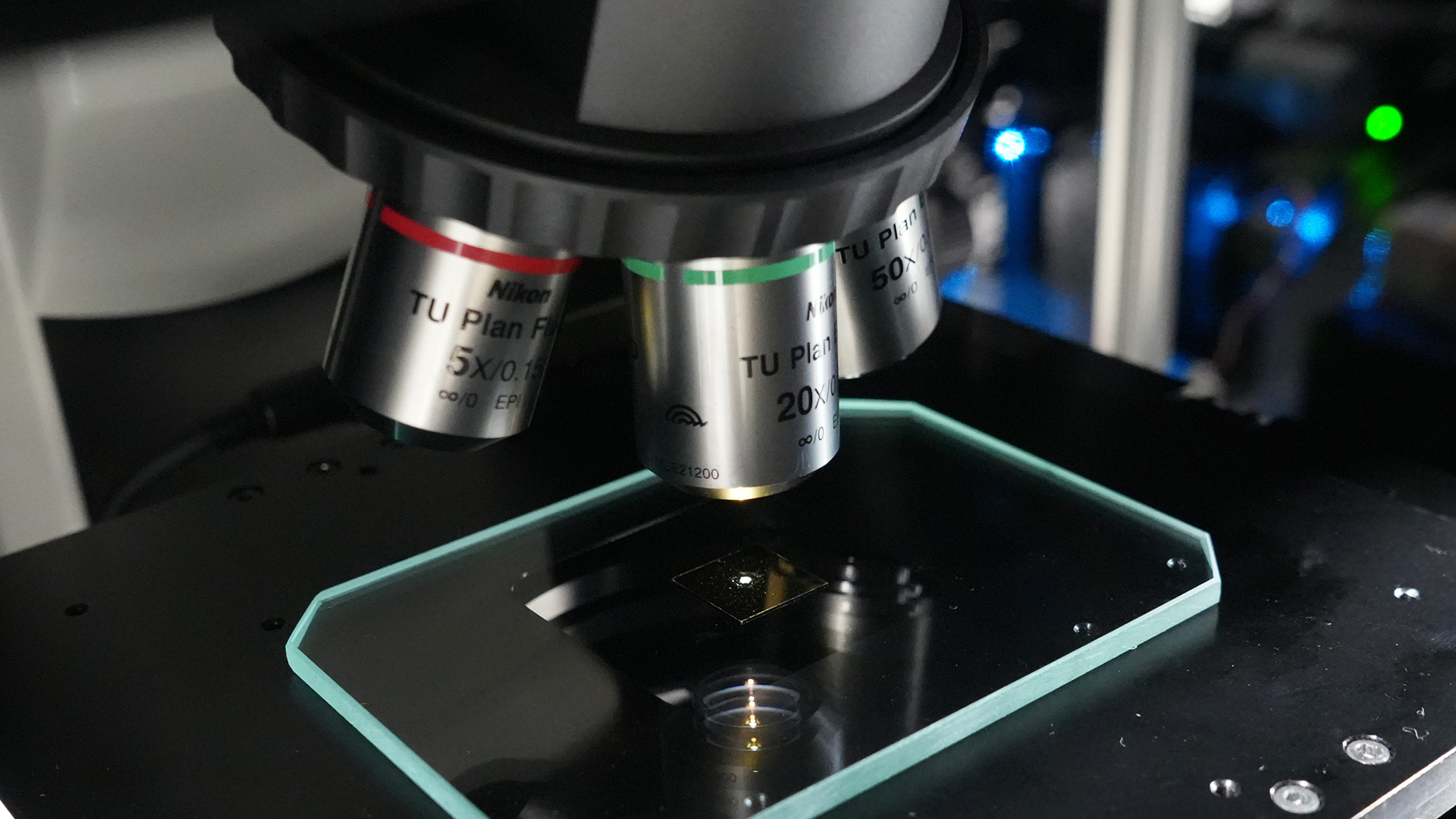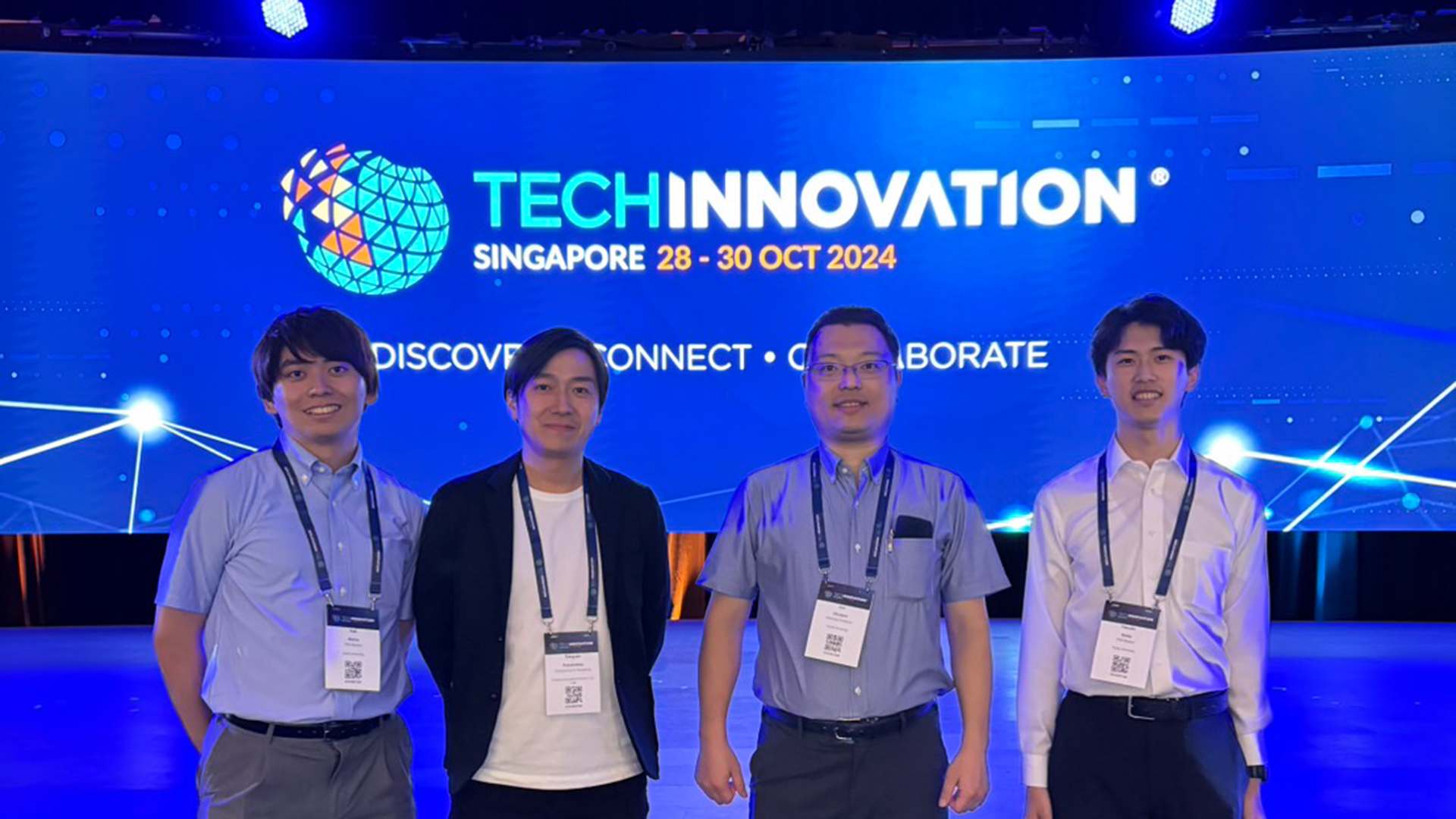- TOP
- About
- Affiliated League
- Information
- League Members
- Partners
- League Report
Search League Members
-
公式X
The progress of AI knows no bounds. As it integrates into every facet of society, creating "lightweight" AI that can be implemented anywhere and used in wearable applications is becoming crucial. Gaining attention in this area is "reservoir computing," a machine learning model that doesn't require vast computational processes or data.
A startup is advancing a world-first venture: realizing reservoir computing by leveraging thermal measurement technology. We spoke with Takayuki Kasamatsu, the representative of "thermalAI," who is steadily preparing to establish the company in the near future, to discuss his vision.
 Mr. Kasamatsu, representative of thermalAI, giving a lecture.
Mr. Kasamatsu, representative of thermalAI, giving a lecture.We hear you're preparing to establish your company. Could you tell us about your journey so far?
Kasamatsu: Growing up watching my grandfather, who ran an apparel business, and my father, who traveled the world to places like Malaysia and Russia, I had an early desire to one day start a business that could compete globally. I designed my career path with the idea of steadily taking steps to learn what is necessary for entrepreneurship.
First, prioritizing an environment where I could work closely with executives, I chose the path of a certified public accountant. After graduating from university, I worked at an auditing firm for nine years. Through work in auditing and advisory, I supported startup IPOs and had the chance to see many executives up close. Some of the startups I was in charge of at the time were listed on the Tokyo Stock Exchange Prime Market, and I was able to experience firsthand the dynamism of a business gaining traction and growing significantly. Every day was stimulating.
So, for your next step, you moved to a business corporation.
Kasamatsu: When you work at an auditing firm, you often find yourself wanting to be inside a startup, growing along with the business, and that was exactly my situation. At my first AI-related company, I served as the head of finance and accounting, driving the IPO from within. Then, I moved to an early-stage startup as the second-in-command, responsible for both business and administration. There, I managed the process all the way to an M&A exit and PMI (Post-Merger Integration), which allowed me to accumulate a wealth of management experience.
In what kind of environment are you currently advancing your business launch?
Kasamatsu: I belong to UTokyo IPC (The University of Tokyo Co-creation Platform Development Co., Ltd.), which provides funding and management support to university-launched startups, as an EIR (Entrepreneur in Residence), and I am working on launching a business that utilizes technology from university professors.
How did you get to know Dr. Jun Hirotani (Associate Professor, Department of Micro Engineering, Graduate School of Engineering, Kyoto University), who is the research lead for thermalAI?
Kasamatsu: I met Dr. Hirotani at a pitch event for the Kansai Startup Academia Coalition (KSAC), where they present research results from their GAP fund (funding to bridge the "gap" between university basic research and commercialization). That was in the spring of 2024.
Dr. Hirotani was looking for a management candidate to start a new thermal management business for controlling and utilizing heat, based on technology he had developed. Meanwhile, I was looking for promising technology seeds to turn into a business, so we were a good match.
 Dr. Jun Hirotani, the research lead for thermalAI.
Dr. Jun Hirotani, the research lead for thermalAI.What is Dr. Hirotani's specific research theme?
Kasamatsu: It is an extremely advanced thermal measurement technology. By using Frequency Domain Thermoreflectance (a method for measuring the thermal properties of materials by utilizing the phenomenon where a material's optical reflectance changes with temperature), we have achieved thermal measurement at the nano and micro scales. We are proud to say this is world-class technology in this field. What we at thermalAI are developing is the application of that technology to utilize normally unused waste heat for "reservoir computing"—the world's first "Thermal Reservoir Computing (TRC)."
What exactly is reservoir computing?
Kasamatsu: While AI is leading the current era, the learning and inference that support technologies like generative AI require enormous computational resources. Reservoir computing is a new machine learning model that significantly simplifies the learning process. It's a technique that learns efficiently with small amounts of data by using an intermediate layer—the "reservoir"—to temporarily store and process data.
In what kinds of situations does this computing technology show its strengths?
Kasamatsu: With its light computational load, reservoir computing can operate at high speeds and with low energy consumption anywhere, making it a great fit for "edge AI"—AI that is installed directly on network terminal equipment (edge devices) like smartwatches and wearables. An analogy I often use is that if deep learning is like the neural network of the cerebrum, edge AI is like a "spinal reflex that acts before you think, bypassing the cerebrum."
Another key feature is that reservoir computing can be implemented in hardware using diverse materials and physical phenomena (light, fluids, nano-molecules, cultured cells, etc.), which are collectively called Physical Reservoir Computing (PRC). In that field, thermalAI is advancing the world's first effort to use waste heat as a computational resource for reservoir computing.
Did you come up with the idea to commercialize TRC—applying thermal measurement technology to reservoir computing—right after meeting Dr. Hirotani?
Kasamatsu: No, we spent about a year exploring ideas together, and at first, a business based on another technology was also on the table. What helped during that process was the knowledge and experience I gained from assisting many startups. I knew full well that startups rarely go according to plan, so I calmly collected my thoughts. From past experience, when things aren't going well and you hit a wall, it's effective to take a small step back and rethink. So I went back to square one, thinking about the business thermalAI should tackle. It was then that we re-examined the commercialization of "reservoir computing," an application that had been on the horizon since Dr. Hirotani's research presentation.
When did the two of you finalize your decision?
Kasamatsu: Around February to March 2025. From that point, we applied for the ICT Startup League. I've learned from experience that you can't take a decisive step unless you are sure of it yourself, and we were able to clearly picture our mission as the social implementation of the groundbreaking technology of TRC. We aim to provide a solution that simultaneously solves two societal problems—"waste heat loss" and "computational loss"—and contribute to a society powered by AI and IoT.
What kind of research will you be tackling in the ICT Startup League?
Kasamatsu: TRC is based on the premise of thermal diagnostics and thermal design based on accurate heat measurement, which requires analysis through AI-powered simulations. Therefore, with the support of the ICT Startup League, we will advance the miniaturization of TRC and the development of simulation software.
The theoretical part is already established, so we are now in the phase of operational verification in real environments. We plan to conduct lab-level demonstration experiments and are building a demo machine with the ultimate goal of achieving a PoC (Proof of Concept: pre-prototype verification) with corporate partners.
What other plans do you have?
Kasamatsu: In addition to demonstration experiments, we want to use the subsidy to apply for patents. In addition to the currently pending patent for TRC, we want to file at least two more applications for use patents and other related patents for TRC.
Could you also tell us about your intellectual property strategy?
Kasamatsu: Our current demonstration experiments are progressing in the form of co-development with companies. Looking ahead, we envision a business model where we will charge a license fee to manufacturers who want to embed TRC into their devices for condition diagnostics, or provide manufacturers with the blueprints for the thermal design for TRC implementation. Acquiring patents is not just about protecting our technology; it's also an "offensive" move to develop our licensing business. We are solidifying this IP strategy in consultation with external patent attorneys.
 Developing world-class thermal measurement technology.
Developing world-class thermal measurement technology.Having seen various excellent technology seeds at places like UTokyo IPC, what kinds of things do you find particularly promising?
Kasamatsu: One key point is being "cutting-edge." For thermalAI's business, that's our "world-class thermal measurement technology." Then there's the scale of the impact on society. I also think it's important how appealing a vision of the future you can paint.
What specific products or solutions do you envision thermalAI bringing to the world?
Kasamatsu: I envision two main patterns. The first is to install our technology in existing devices that already have temperature sensors to upgrade their performance. I think this implementation could proceed smoothly, and the licensing model I mentioned earlier might be effective.
The second pattern is adding it on to products that didn't have it before. This could take the form of "providing a solution," such as an anomaly detection kit.
In either case, for the time being, the core functions will be sensing that leverages TRC's real-time capabilities and learning based on that data.
It seems to have a wide range of potential applications. What industries are currently showing interest?
Kasamatsu: In the short term, we foresee its adoption in manufacturers' production processes. For instance, detecting the condition of manufacturing equipment before it breaks down to improve quality and productivity, and to prevent accidents. Also, with the recent issue of lithium-ion battery fires, we are in discussions with insurance companies about a solution that can sense and make judgments on the signs of thermal runaway.
In the medium to long term, we aim for its use as a physical AI (an AI that perceives and acts in real-world physical situations). This includes contributions to robotics, where a robot could detect temperatures and make decisions on its own. I also believe there's potential in the medical field, for applications like 24-hour body temperature sensing.
Beyond that, it could be used in a wide range of fields such as telecommunications carriers, network infrastructure, data centers, automotive, and aerospace. In any case, when I talk with potential customers, unexpected ideas just keep coming. That's fun, but I don't forget that it's my job to prioritize and create a strategy so these don't just become scattered dreams (laughs).
What does the future roadmap for thermalAI look like?
Kasamatsu: If everything goes extremely smoothly, there's a possibility we could establish the company in 2026, but we might take another one or two years to proceed carefully. We are aiming to launch the business by 2028 at the latest.
What are your impressions of participating in the ICT Startup League?
Kasamatsu: In addition to the subsidy system, I'm really feeling the benefits of participating in terms of building connections. We get to connect with business corporations and meet other highly ambitious entrepreneurs, which is very motivating. We can also share the kinds of problems that are unique to the early stage.
The ICT Startup League has a feeling of being built by everyone involved, and the high level of passion is impressive. As thermalAI, with heat technology at our core, we want to bring the same level of passion and not be outdone.
 The members of thermalAI, continuing to take on challenges every day.
The members of thermalAI, continuing to take on challenges every day.
Editor's Note
Reservoir computing is a technology gaining significant attention as we stand on the cusp of an era where AI will fully permeate society. The business concept of implementing it by leveraging world-class thermal measurement technology is highly convincing.
Mr. Kasamatsu also noted that through his activities as an EIR, he has been impressed by the high potential and uniqueness of the various technology seeds lying dormant in Japan's universities. He shared his future vision of contributing to an ecosystem that better recognizes university-born technologies and promotes their social implementation.
A major challenge for Japan's intellectual property strategy is this very issue of "utilizing dormant university patents." While the gap in the number of patents between Japanese and U.S. universities is about twofold, when it comes to patent income, the U.S. earns 50 times more than Japan. We have high hopes that Mr. Kasamatsu's initiative will be a step toward changing this situation.
■ICT Startup League
This is a support program launched in FY2023, initiated by the Ministry of Internal Affairs and Communications' "Program to Support Emerging R&D for Startup Creation."
The ICT Startup League supports startups through four pillars.
① R&D Funding / Hands-on Support
Up to 20 million yen in R&D expenses is provided in the form of a subsidy. Additionally, through hands-on support, the selection committee members involved in choosing league members continue to stay engaged post-selection to foster growth. For companies that a committee member evaluates as a "must-select," a dedicated support system is in place where the committee member themselves continuously provides advice on the business plan and offers growth opportunities—a true "cheering squad" style of support.
② Discovery & Nurturing
We provide opportunities for learning and networking to promote the business growth of league members.
We also work to discover aspiring entrepreneurs to broaden the base of participation.
③ Competition & Co-creation
It serves as a place for positive competition, much like a sports league, with a system where startups learn together and compete constructively to win the funding they truly need (up to 20 million yen). We also provide a venue for co-creation, where league members can collaborate and expand their businesses through various opportunities, including sessions with selection committee members.
④ Promotion
We will promote the initiatives of league members in collaboration with the media! By making their businesses known to many people, we aim to expand opportunities for new matching and chances.
■Related Websites
thermalAI (LEAGUE MEMBER)
/
ICT Startup League